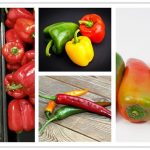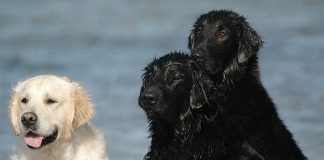
Origin
A black Goldendoodle is the result of pairing a black Standard Poodle and a Golden Retriever. Black is actually one of the unaccepted coat colors in the Golden Retriever, that’s why black is mostly derived from the Poodle parent.
Poodles come in various shades and black is a fairly common color in this breed. The breed is well-known for producing muted colors ranging from chocolate to the darker ones like gray and eventually black. However, this black coat color is not always meant to stay forever even if you have a true black Poodle dog.
Black Goldendoodles may have the same deep black color like their Poodle parent as well as its beautiful and dark brown eyes. Both the face and the body share the same black hue. Unlike black dogs from other breeds, you will not see a hint of silver or blue in their coat.
Some pups may appear like they have a deep black color only to turn a bit grey as they get older. It’s pretty normal, because just like people, dogs produce less melanin as they mature. But do note that aging is not the only reason why a dog’s black hair will turn grey. Premature greying can be because of stress, poor nutrition, and even anxiety.
Based on the American Kennel Club’s breed standards, Golden Retrievers may come in several shades except anything that is too light or too dark. The black ones you see are flat-coated retrievers which share many similarities with Golden Retrievers but still have some differences.
Appearance
Like a typical Goldendoodle, black Doodles are medium in terms of size. Their height and weight will actually depend on the variety of Poodle they come from. If one of the parents is a miniature type, you can expect your Doodle to weigh anywhere between 15-30 lbs. If it’s an offspring of a Golden Retriever and a Standard Poodle, expect the dog to be 45 up to 100 lbs.
Black Goldendoodles have very dark claws, nose and eyes, in addition to their deep black coloring. Their black color is so vibrant,they are difficult to spot in the dark. However, not all of them are entirely black. Some dogs will have spots of white or brown on the chest and paws.
Black Goldendoodles Personality
Black dogs, in general, are often seen as more aggressive than the lighter ones like yellow or brown. But this is not the case with Goldendoodles. The kind of their living environment and their common breed traits will have more impact on their personalities than their coat color. As with humans, dogs are individuals so they will have varying traits and personalities.
Your black Goldendoodle may inherit some of the common Poodle traits. Although Poodles are often associated with class and status quo, they are actually working dogs. Don’t be surprised if your Doodle dog likes being active and looking for adventures rather than lying down in his crate or bed. They were originally bred to hunt in their native country Germany before they gained popularity in other parts of Europe like Spain and France.
Black Goldendoodle Coat Types
As with any other shade of Goldendoodle, the black ones may come in different textures. The coat type will differ depending on the generation of the dog. These are the different coat types of Goldendoodles and their features:
Wavy – also called shaggy, a wavy coat is popular among black Goldendoodles. It combines the soft waves of the Golden retriever and the tight curls of the Poodle. Doodles with a wavy coat are easy to groom but not as easy to maintain as the straight ones. Black Goldendoodles with a wavy coat require once or twice more brushing in addition to the trips to the professional groomer every eight weeks. These dogs shed minimally and may not be as hypoallergenic as the curly ones.
Curly – The most common types you will find are the curly Goldendoodles yet they are also the most challenging to groom. The best part about them is they almost don’t shed and this is why they are considered to be hypoallergenic. This makes them ideal for people with a history of pet allergies but who are eager to adopt a dog. Most of them will have the same kinky locks as the Poodles, which need regular brushing. Grooming them only twice or thrice a week will make them more prone to developing mats and tangles. A black F1B Goldendoodle will likely have this type of coat because it has more of the Poodle gene in it.
Straight – Black Goldendoodles with a straight coat are the rarest of all. However, there is a big chance you will have a straight-coated doodle if it has more of the Golden Retriever gene in its lineage. For example, it could have 75 percent of Golden Retriever and only 25 percent of the Poodle gene. It rarely occurs in F1 or F1B or those having more of the Poodle gene in their lineage. Brushing them once a week will be enough to maintain their coat. These dogs are the easiest to groom but take note that they may not be the kind of hypoallergenic dog you are looking for.
Grooming
Black dogs are a bit more challenging to groom than light-colored dogs. There is not much difference when it comes to their brushing requirements, but you will soon learn that bathing and trimming them is a bit more time consuming than grooming a cream or brown Doodle.
The first concern you will have is trimming their nails. You will know the nails are ready for trimming if the dog’s claws are already protruding over their pad. Their “quick” or blood vessel is not as visible as that of their lighter colored counterparts, so you need to be more careful with cutting their nails short. Imagine how nerve-wracking it will be, especially if you are a new pet parent!
To begin with, hold your dog’s paws as gentle as you can and trim the nails at a 45-degree angle. Avoid cutting side by side so you will not get to the quick and accidentally cut it. A guillotine style trimmer is suitable for small to medium sized dogs. However, a scissor-style trimmer is more user-friendly although it is not as precise as guillotine trimmers.
When trimming the dog’s nails, it helps to have styptic powder ready. It’s possible you will still cut the quick even if you are very careful when cutting your dog’s nails. Styptic powder works by reducing the bleeding caused by cutting the quick. You never know when accidents occur so better keep some styptic powder in your grooming kit.
Another concern with black dogs is that most of them easily lose the sheen look they used to have. The best solution to this is to keep the coat naturally shiny with healthy fats like omega-3 and omega-6. Many pet parents even use black shampoos with built-in conditioners to effectively clean and condition the dog’s coat but there are no clinical evidences that these products are truly efficient.
Black Goldendoodles Health
Goldendoodles have a lifespan of 10 to 15 years. Their life expectancy is around the same as the average life span of their parents. Goldendoodles are considered as fairly healthy dogs because they benefit from having a hybrid vigor. However, it does not mean these dogs are free from canine disorders that normally occur in their parents. They are still likely to inherit some conditions present in both Golden retrievers and Poodles, like the following:
Sub-valvular Aortic Stenosis – this heart condition affects a number of breeds and Golden Retrieversare among those predisposed to it. With this condition, a dog’s aortic valve becomes narrow due to abnormal tissue located in it. Problems in the aorta can be serious since this large artery plays many important roles in body, like distributing blood to organs like kidneys and intestines. Because it affects the normal flow of blood in the body, it can make a dog weak or make him experience difficulty in breathing.
Addison’s disease – also called hypoadrenocorticism, this condition is a result of the abnormal production of the cortisol hormones. This disease is not very common, although it may affect certain breeds and ages. Studies indicate the dogs in their young or middle age tend to acquire it more. The cause remains unknown although experts believe it’s triggered by adrenal gland destruction and haemorrhage.
Sebaceous adenitis – this recessive genetic trait occurs when an animal’s sebaceous gland fail to produce a sufficient amount of sebum. Unfortunately, the Poodles are at risk for passing it on to their offspring and the Goldendoodles are not an exception. This results in skin dryness, hair loss, and in some instances, skin infections. Although this skin problem cannot be cured, there are many ways to manage it including the application of topical medication and frequent bathes. Dogs suffering from this condition may also require a special diet to prevent their skin from drying further.
Hip dysplasia – this condition affects many medium and large breeds, and the Golden Retrievers and Poodles are among those predisposed to it. Canine hip dysplasia is one of the genetic diseases Goldendoodles may acquire. It pertains to the abnormal formation of the hip socket. If not treated immediately, hip dysplasia can be painful and can even result in arthritis. Some early signs to keep an eye on are reluctance to move and lameness.
Cataracts – they can prejudice a dog’s normal vision depending on their size. Small or newly acquired cataracts are not obvious until you take a closer look at your dog’s eyes. Also, it does not have any impact on a dog’s ability to see. Most dogs can live a normal life even with small cataracts. These types of cataracts also don’t need surgical removal. However, a dog will start suffering from vision loss if the cataracts are larger or if the opacity of their lens is greater than 60%. This is the type that should be removed, otherwise it can make a dog completely blind.
Glaucoma – another eye problem that may affect Goldendoodles, glaucoma is a problem in the optic nerve that involves the loss of retinal ganglion cells. Sadly enough, almost half of all dogs suffering from glaucoma end up blind after just one year. This is in spite of having acquired any therapeutic or surgical treatment. Canine glaucoma is often characterized by loss of appetite, having no interest in the usual activities, and signs of headache like pressing the head on something like a wall.
Black Goldendoodles Price
The price of a black Goldendoodle ranges from $2,500-$3,000 depending on breeder. Males and females usually come with the same price tag but dogs from champion bloodlines will obviously cost more than the others. Dogs with champion bloodlines have one or both parent that has won in canine competitions. In general, the black Doodles are less expensive than dogs with a caramel or partial white and brown color.
Conclusion
If you want to own a black Goldendoodle, you might want to look for breeders of a black Poodle and a golden retriever. This increases your chances of getting a true black Goldendoodle dog. Finding a breeder of a Goldendoodle puppy is easy since these Doodles are among the most popular crossbreeds. But be wary when searching for breeders online because some of them are actually puppy mills and not reputable breeders.






















